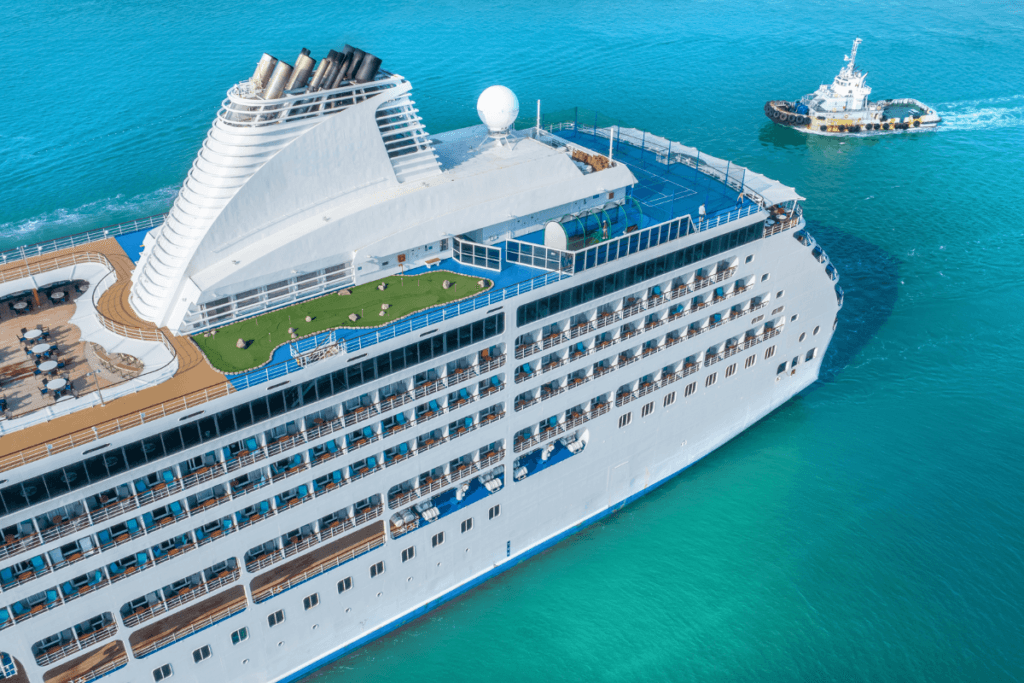Planning a cruise vacation seems like the ultimate dream escape: breathtaking views, gourmet dining, and endless entertainment, all wrapped up in one convenient package. But while cruises promise an all-inclusive experience, there are often a range of hidden costs that can leave you with sticker shock if you aren’t prepared. From excursions to onboard services, these extra expenses can add up quickly. But don’t worry—I’m here to break down everything you need to know about cruise costs so that you can budget wisely and enjoy your vacation stress-free.
On the page:
Understanding the Basics: What’s Included in the Cruise Fare

WWhen you book a cruise, it’s easy to get excited about the all-inclusive nature of your fare, which generally covers a significant range of services and amenities. Your accommodations are included, with prices varying based on your choice of cabin—ranging from basic inside staterooms to oceanview cabins, private balconies, and spacious suites. Meals are another major inclusion: you’ll have access to main dining rooms, buffets, and several casual spots without any additional cost. These venues serve a variety of cuisines to satisfy your cravings throughout the day.
Onboard entertainment and activities are also part of the package. From Broadway-style theater productions to live music, comedy acts, trivia games, and poolside fun, you’ll find endless ways to enjoy your time at sea without spending extra. Fitness classes, some sporting events, and certain kids’ clubs are often included as well.
However, it’s important to understand what isn’t covered, as these extras can add up quickly. Specialty dining options, such as steakhouses or celebrity chef restaurants, typically come with an additional charge. Drinks beyond basic offerings (like alcohol, specialty coffee, and bottled water) also cost extra, and many cruise lines offer beverage packages to help offset these expenses. Shore excursions and guided tours at each port are not included and can vary greatly in price, depending on the destination and type of adventure you select.
Additional costs may also sneak up in the form of spa treatments, Wi-Fi packages, and gratuities for the crew. Some fitness classes, like Pilates or spin, may require a fee as well. It’s wise to budget for these extras in advance to avoid surprises, ensuring your dream cruise experience remains as enjoyable and stress-free as possible.
The Hidden Costs You Should Watch Out For
- Gratuities and Service Fees
Most cruise lines charge a daily gratuity or service fee per person. This can range from $14 to $20 per day, depending on the line and the type of stateroom. If you’re a family of four on a seven-night cruise, these gratuities can add up to several hundred dollars. While some lines allow you to adjust or prepay gratuities, most strongly encourage paying the set amounts to reward the hardworking staff onboard.
Pro Tip: Check your cruise line’s policy on gratuities and budget accordingly. You may also have the option to adjust the gratuity amount if the service doesn’t meet expectations, but this is generally discouraged unless necessary.
- Excursions and Shore Activities
Shore excursions can be some of the priciest extras. A simple city tour may cost $50 per person, while more elaborate experiences like helicopter rides or scuba diving excursions can run hundreds of dollars. While you can always explore port cities on your own, be aware that some destinations are best experienced with a guide.
Recommendation: Plan your excursions in advance to take advantage of early booking discounts or consider independent tour operators for potentially lower prices. Be sure to research reviews and safety standards before booking outside the cruise line.
- Specialty Dining
While most meals are covered, specialty restaurants on the ship often come with a surcharge. These premium dining experiences can range from $20 to $100 per person. Think steak houses, sushi bars, and chef’s table experiences.
Cost-saving Tip: If you’re a foodie but don’t want to break the bank, look for discounts offered on embarkation day or during lunch hours, as many cruise lines offer dining deals then.
- Alcohol and Specialty Beverages
Most cruises offer complimentary tea, coffee, water, and sometimes juice. However, alcoholic drinks, sodas, and specialty coffees usually cost extra. Drink packages can range from $50 to $90 per day, depending on the cruise line and the types of beverages included.
Budget Advice: Calculate how much you actually drink to see if a beverage package is worth it. If you only have a few drinks a day, paying à la carte may be cheaper. Some cruises also allow passengers to bring a limited amount of their own alcohol onboard, so check the policy.
- Wi-Fi and Internet Access
Staying connected at sea isn’t cheap. Internet packages can be slow and costly, with some cruise lines charging up to $30 per day or offering packages based on data usage.
Cost-saving Strategy: If you can, disconnect and enjoy your time at sea. Alternatively, wait until you’re in port to use free or more affordable Wi-Fi at local cafes.
- Spa Treatments and Fitness Classes
Pampering yourself at the onboard spa can be tempting, but massages, facials, and other treatments can cost anywhere from $100 to $300 each. Even specialty fitness classes like yoga or spin may come with a fee.
Pro Tip: Keep an eye out for spa deals offered on port days when fewer passengers are onboard. Some ships also offer discounts on the first or last days of the cruise.
- Photos and Souvenirs
Cruise photographers will capture every moment of your trip, from formal dinners to port arrivals. However, these professional photos come at a price—often $15 to $25 per picture. On top of that, souvenirs from the gift shops are often marked up.
Money-saving Idea: Take your own photos to capture memories or budget for just one or two professional shots as keepsakes.
- Laundry Services
Unless your cruise is only a few days long, you may eventually need some clean clothes. Onboard laundry services, however, can be pricey. Most cruise lines charge anywhere from $3 to $7 per item for laundering, which can quickly add up if you’re washing multiple pieces. Some ships have self-service laundry rooms that are more budget-friendly, but these are not always available. To save money, consider packing enough outfits for your entire cruise or bringing travel-sized laundry detergent to wash smaller items in your cabin sink. This way, you can avoid those high laundry service costs.
Budget Tip: Bring a small amount of detergent for hand-washing or check if your cruise line has self-service laundry facilities, which are generally more affordable.
- Medical Services
Cruise ships have onboard medical facilities, but visits aren’t cheap. Even a simple consultation can cost over $100, and any medication or treatment will add to the bill.
Advice: Make sure you have travel insurance that covers medical emergencies, especially if your cruise includes international waters.
How to Budget Effectively for Your Cruise

- Set a Realistic Budget Before You Book
The first step in planning a cruise vacation is setting a realistic budget. Take into account the entire cost of your vacation, not just the price of the cruise fare. This includes airfare, accommodations (if you need to stay overnight near the port), transportation to and from the cruise terminal, and any extra expenses like shopping and dining during port visits.
Once you have an overall figure in mind, consider prepaying for packages that might save you money, such as drink packages, specialty dining plans, or spa services. These packages can be worth it if you plan to use them frequently, but make sure to calculate whether the cost matches your actual needs. For instance, if you aren’t a heavy drinker, paying for an unlimited alcohol package may not be cost-effective.
Example: If your total budget is $5,000 for a week-long cruise, you could allocate $3,000 for the cruise fare and essentials, $1,000 for excursions, and the rest for additional spending.
- Research Your Cruise Line’s Inclusions and Exclusions
Not all cruise lines are created equal when it comes to what’s included in your fare. Luxury lines like Regent Seven Seas Cruises or Seabourn often include amenities like shore excursions, alcohol, gratuities, and even Wi-Fi, whereas budget-friendly lines like Carnival or Norwegian Cruise Line operate on a more à la carte basis. Understanding these differences is crucial to avoid hidden costs.
Take the time to compare cruise lines and ships based on what matters most to you. If you’re a food enthusiast, a line known for its exceptional complimentary dining options may save you money compared to one where you’d be tempted to splurge on specialty restaurants. Similarly, if you can’t imagine your vacation without unlimited internet access, you may want to prioritize a line that offers affordable Wi-Fi packages or includes internet in the fare.
Recommendation: Make a list of must-have amenities and use it to evaluate which cruise line offers the best value for your needs.
- Take Advantage of Deals and Discounts
Cruise lines frequently run promotions, and timing your booking can make a big difference in what you pay. These deals might include free onboard credit (which you can use for drinks, dining, or excursions), discounted drink packages, reduced deposits, or even cabin upgrades.
Sign up for newsletters and alerts from cruise lines and travel booking websites to stay informed about special offers. Some of the best deals often appear during wave season (January to March), when cruise companies offer significant incentives to secure bookings. If your dates are flexible, consider traveling during the off-season for cheaper rates.
Tip: Use a travel agent who specializes in cruises, as they often have access to exclusive deals and can provide valuable insights into which promotions are genuinely worth it.
- Be Smart About Onboard Spending
Once you’re on the ship, it’s easy to lose track of spending with so many activities and attractions vying for your attention. Setting daily spending limits for yourself and your travel companions can help manage costs. Many cruise lines have apps or onboard account systems that allow you to monitor your spending in real time. Check your account regularly to ensure you’re staying on budget and not accumulating unexpected charges.
Consider sticking to complimentary activities and dining options whenever possible. Attend free entertainment shows, take advantage of included amenities like the pool and gym, and participate in no-cost activities organized by the cruise staff. Limiting impulse purchases, like expensive cocktails or souvenirs, can also help keep your budget in check.
Cost-saving Tip: Allocate a fixed amount of cash for each day, especially for things like casino play or spontaneous purchases, and once it’s gone, commit to not spending more.
- Book Excursions and Services in Advance
Excursions and onboard services can be more expensive if booked on the spot, so consider planning and paying for these experiences before your cruise. Many cruise lines offer discounts for early bookings, and you’ll have a wider selection of options to choose from. Shore excursions, in particular, tend to fill up fast, especially in popular ports, so booking early ensures you don’t miss out.
For services like spa treatments or specialty dining, pre-booking can also be beneficial. Some ships offer embarkation day specials or bundle deals, so check for promotions before your cruise. If you’re interested in independent tours at port destinations, research reputable operators in advance. They’re often cheaper than the cruise-organized versions but may require more planning.
Advice: Weigh the pros and cons of booking through the cruise line versus independently. While independent tours can be cheaper, they may not offer the same level of guarantee if you’re delayed getting back to the ship.
Additional Tips for a Cost-Effective Cruise Experience

- Pack Smartly to Avoid Hidden Costs
One of the simplest yet most effective ways to save money on your cruise is to pack strategically. Essentials like sunscreen, motion sickness medicine, and common over-the-counter medications often come with inflated prices on the ship and at port shops. Make sure to stock up on these items before your trip to avoid paying a premium.
Additionally, if your itinerary includes water activities, bringing your own snorkel gear or water shoes can save rental fees. Even a reusable water bottle can be a money-saver, as many cruise lines allow you to refill it at designated stations onboard. For families, packing items like pool toys and basic first aid supplies can also prevent unnecessary spending.
Cost-saving Tip: Make a comprehensive packing checklist in advance to ensure you don’t forget any essentials, and consider packing an extra carry-on for souvenirs to avoid overweight luggage fees on your return flight.
- Use Your Cruise Line’s Loyalty Program
Frequent cruisers should take advantage of their cruise line’s loyalty or rewards program. These programs, which are free to join, often offer significant perks to returning passengers. Depending on your tier level, you might receive discounts on future bookings, priority boarding, complimentary drinks, or even free Wi-Fi. As you accumulate points from multiple cruises, the benefits only get better.
For instance, Royal Caribbean’s Crown & Anchor Society offers members perks like exclusive events, discounts on suite cabins, and bonus points for longer cruises. Similarly, Carnival’s VIFP Club rewards you with benefits ranging from free chocolate-dipped strawberries to members-only offers. These perks can make your cruise experience more luxurious without extra costs.
Recommendation: If you’re unsure which cruise line to choose and plan to cruise regularly, consider committing to one line to maximize your loyalty benefits over time.
- Keep an Eye on Exchange Rates
If your cruise includes international destinations, being mindful of currency exchange rates can be a game changer. When shopping at ports or booking excursions, fluctuations in exchange rates can impact your overall cost. Doing a bit of research beforehand to know the current rates and understanding how they might shift can help you make cost-effective decisions.
Consider exchanging some money in advance or using a credit card that offers favorable international transaction rates. Some ports may accept U.S. dollars or euros, but it’s always wise to have local currency for smaller vendors or tips. Additionally, ATMs in foreign countries often charge fees, so withdrawing a reasonable amount in one go can save you from repeated charges.
Advice: Download an exchange rate app or use a travel-friendly credit card with no foreign transaction fees to get the best value during your shore excursions.
You may also like: The wonders of Norway in a Nutshell
Conclusion: Enjoy Your Cruise Without Financial Stress
Cruises can be a fantastic way to see the world, but understanding and preparing for the hidden costs can make a significant difference in your overall experience. By doing your homework and budgeting effectively, you can avoid surprises and focus on creating unforgettable memories. After all, the only thing you should be worrying about is whether to lounge by the pool or catch that evening show.
Remember, a well-budgeted trip means more peace of mind and more enjoyment. Now that you know what to expect, you’re ready to plan your dream cruise with confidence!



